| Second Seminole War |
| Conflict in Florida from 1835 to 1842 |
| Description | A conflict between the United States and the Seminoles, consisting of American Indians and Black Indians, in Florida |
| Causes | Tensions after the Treaty of Payne’s Landing in 1832, which called for the Seminoles’ removal from Florida |
| Date | December 23, 1835 – August 14, 1842 (6 years, 7 months, 3 weeks, and 1 day) |
| Location | Florida, United States |
| Result | Nominal end to conflict; no peace treaty; ~4,000 Seminoles forcibly transported to Indian Territory; ~575 remained in Florida; led to Third Seminole War in 1855 |
| Significance | Regarded as the longest and most costly of the Indian conflicts of the United States |
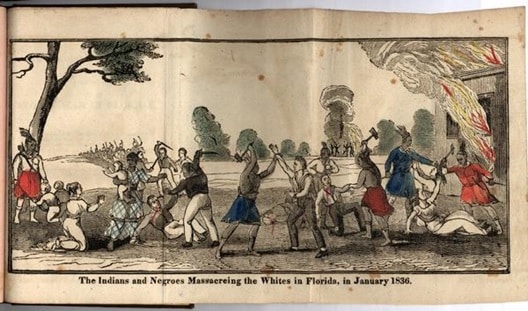
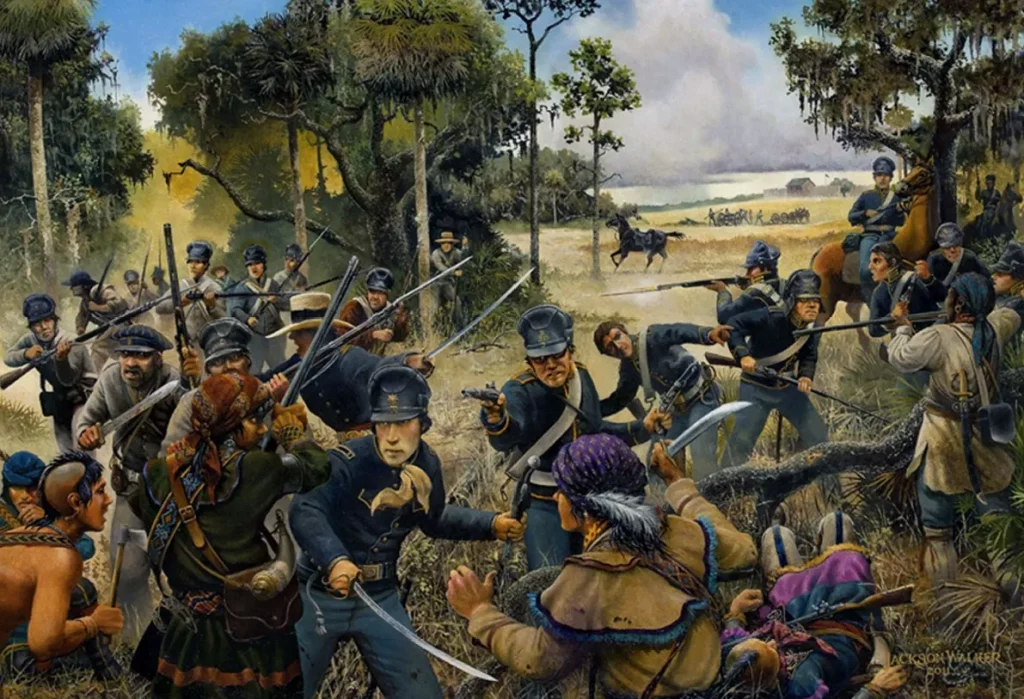
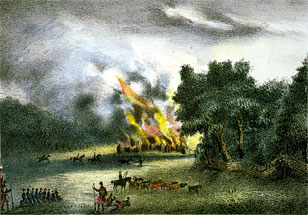
The key details about the Second Seminole War (1835-1842)
Background and Causes:
- The war arose from the U.S. government’s efforts to forcibly relocate the Seminole Indians from their lands in Florida to the Creek reservation west of the Mississippi River as part of the Indian Removal Act of 1830.
- The Treaty of Payne’s Landing in 1832 required the Seminoles to move within 3 years if they found the western lands suitable, but many Seminole leaders like Micanopy and Osceola repudiated the treaty.
Key Battles and Events:
- The war began on December 28, 1835 when Seminoles led by Micanopy ambushed and massacred 110 men under Major Francis Dade, leaving only 3 survivors. This became known as the Dade Massacre.
- Other major engagements included the Battle of Withlacoochee in 1836, where U.S. forces were defeated by Seminoles.
- Seminole leader Osceola was captured under a flag of truce in 1837, but the war continued under chiefs like Micanopy and Halleck Tustenuggee.
- The U.S. employed tactics like blockading the Seminoles, destroying their crops and villages, and offering bounties for their capture.
Outcome:
- By 1842, most of the remaining Seminoles were either killed, forced to surrender, or retreated deep into the Everglades.
- Around 3,000-5,500 Seminoles were killed during the war.
- The U.S. lost over 1,500 soldiers and spent over $20 million on the prolonged conflict.
- Though no peace treaty was signed, the war was declared over in 1842 with most Seminoles forcibly relocated to Indian Territory (Oklahoma).
The Second Seminole War was the longest, deadliest, and most costly of the three Seminole Wars. It demonstrated the fierce Seminole resistance to forced relocation and their effective use of guerrilla tactics against the better-equipped U.S. forces in the swamps of Florida. The war ended in a technical U.S. victory but at an extremely high cost.
Key battles of the Second Seminole War
Here were some of the key battles of the Second Seminole War (1835-1842):
- Dade Massacre (December 1835)
This was the opening engagement that sparked the war. A force of 180 U.S. soldiers under Major Francis L. Dade were ambushed and decimated by Seminole warriors led by chiefs Micanopy, Alligator and Jumper near the Withlacoochee River. Only 3 men survived the attack. - Battle of Withlacoochee (December 1835 – January 1836)
Following the Dade Massacre, Seminoles led by Micanopy repelled multiple attempts by U.S. forces under General Duncan Clinch to cross the Withlacoochee River into Seminole territory. - Battle of Lake Okeechobee (December 1837)
This was the only major pitched battle of the war. Colonel Zachary Taylor’s forces engaged and defeated Seminoles led by chiefs Sam Jones, Alligator and Coacoochee near Lake Okeechobee, though at heavy cost with over 25% casualties. - Battle of Loxahatchee (January 1838)
A contingent of sailors and soldiers led by Lt. Levin Powell engaged and defeated a large force of Seminoles under chief Sam Jones along the Loxahatchee River. - Battle of Caloosahatchee (July 1839)
U.S. forces under Colonel William Harney tracked down and attacked a large Seminole camp led by chiefs Chitto Tustenuggee and Coacoochee along the Caloosahatchee River. - Battle of Okeechobee (December 1837)
Zachary Taylor’s forces engaged Seminoles under chiefs Alligator, Sam Jones and Coacoochee in a major battle near Lake Okeechobee, resulting in heavy casualties on both sides
While the war consisted mostly of skirmishes and raids, these were some of the largest engagements where U.S. forces directly clashed with concentrated Seminole warriors, often at great cost. The battles demonstrated the Seminoles’ effective use of guerrilla tactics and their fierce resistance to removal from Florida.
Key figures in the Second Seminole War
Here were some of the key figures involved in the Second Seminole War (1835-1842):
Seminole Leaders:
- Micanopy – Principal chief who led Seminole forces in the early battles like the Dade Massacre and Battle of Withlacoochee.
- Osceola – Influential warrior and leader who resisted removal and was captured under a flag of truce in 1837.
- Abiaca (Sam Jones) – Seminole chief who continued fighting after Osceola’s capture.
- Coacoochee (Wildcat) – Seminole chief who led warriors at battles like Okeechobee.
- Halleck Tustenuggee – Prominent chief who directed Seminole resistance in later stages of the war.
U.S. Military Commanders:
- Major Francis L. Dade – Led U.S. forces ambushed and massacred by Seminoles in 1835, sparking the war.
- General Duncan L. Clinch – Early commander who engaged Seminoles at battles like Withlacoochee.
- General Thomas S. Jesup – Led U.S. forces 1836-1838 and controversially captured Osceola under a flag of truce.
- General Zachary Taylor – Commanded troops at the major Battle of Okeechobee in 1837. Later became President.
- Colonel William J. Worth – Final commander who pushed remaining Seminoles into the Everglades by 1842.
Other Figures:
- Lewis Cass – Secretary of War who directed the U.S. military campaigns.
- James Gadsden – Diplomat who negotiated treaties with Seminoles prior to the war.
The Second Seminole War involved a lengthy struggle between determined Seminole chiefs like Micanopy, Osceola and Halleck against a succession of U.S. military commanders like Jesup, Taylor and Worth who ultimately failed to completely defeat the Seminole resistance in Florida.
Influence of the Dade Massacre on the Second Seminole War
The Dade Massacre was a pivotal event that escalated and significantly influenced the course of the Second Seminole War (1835-1842). Based on the provided sources, here are the key ways the massacre impacted the war:
- It sparked the outbreak of the Second Seminole War.
The massacre of Major Francis L. Dade’s command of 110 soldiers by Seminole warriors led by chiefs Micanopy and Jumper on December 28, 1835 near the Withlacoochee River was the first major battle of the conflict. This shocking violence against a U.S. military force essentially ignited the long and bloody Second Seminole War. - It galvanized public outrage and military response.
The brutal killing of Dade’s troops, leaving only three survivors, caused national outrage and calls for the U.S. government to harshly punish the Seminoles. This pressured the military to commit significant forces to subdue the Seminole resistance in the aftermath of the massacre. - It demonstrated the Seminoles’ fierce resistance to relocation.
The ambush showed the Seminoles, under leaders like Micanopy and Osceola, were prepared to use extreme violence to resist forced relocation from their Florida lands per the Treaty of Payne’s Landing. This set the stage for a protracted guerrilla war. - It exposed weaknesses in the U.S. military’s frontier deployments.
The ability of the Seminoles to utterly destroy Dade’s command revealed the vulnerabilities of isolated U.S. forces operating in Florida’s interior. This influenced subsequent military strategies and deployments during the war. - It became a rallying symbol for both sides.
For the Seminoles, the Dade Massacre represented successful resistance against U.S. forces. For the Americans, it became a symbolic event fueling determination to defeat the Seminoles, leading to memorials like the Dade Pyramids
The Dade Massacre demonstrated the Seminoles’ resolve to violently resist relocation, while also exposing weaknesses in the U.S. military’s preparedness. Its impact as both the catalyst for war and a rallying event for both sides ensured the massacre profoundly shaped the escalation and prolonged nature of the Second Seminole War.
Significance of the Battle of Lake Okeechobee
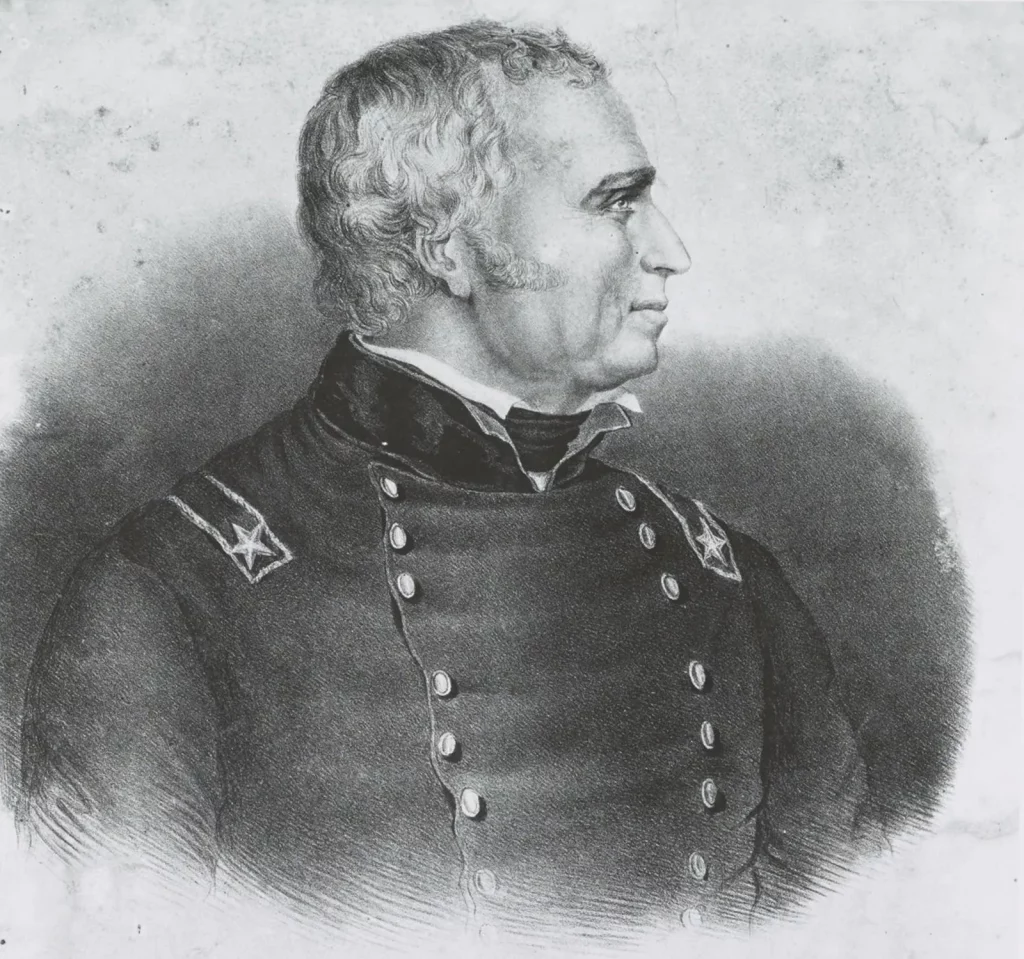
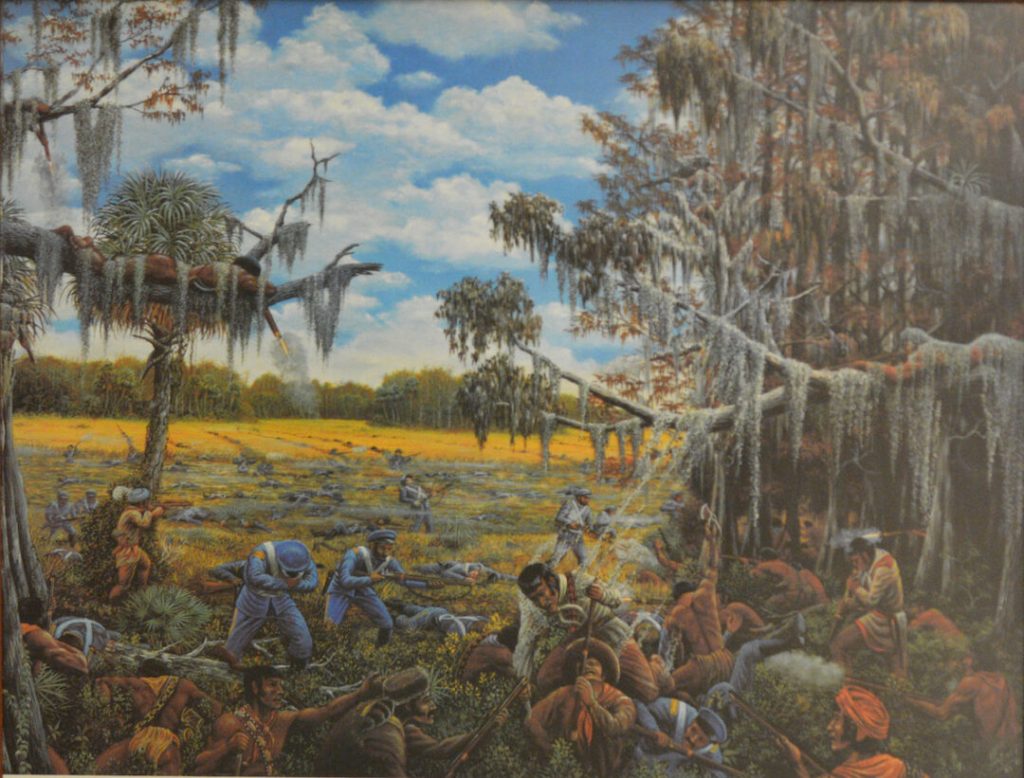
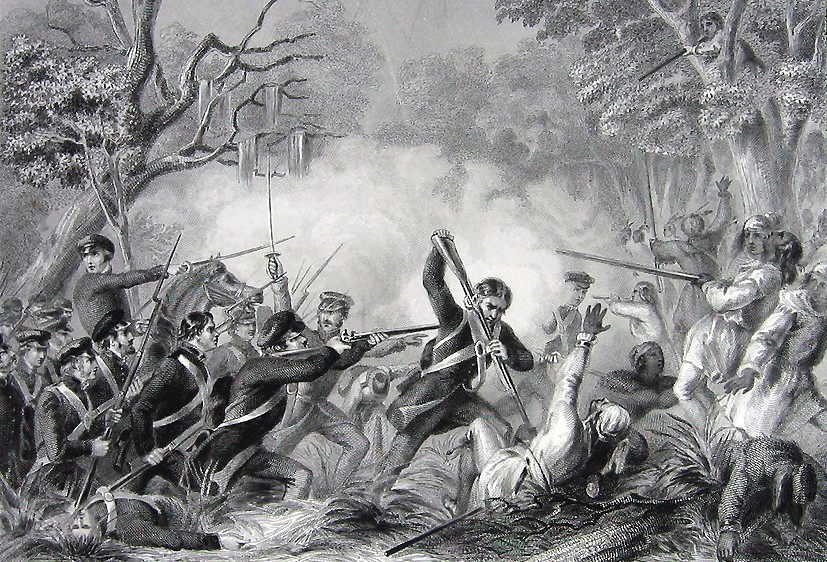
The Battle of Lake Okeechobee was a significant engagement during the Second Seminole War that had the following major implications:
- It was one of the bloodiest battles of the war, with heavy casualties on both sides. The U.S. forces suffered 26 killed and 112 wounded out of around 800 men, while the Seminoles had around 25 casualties out of 380-480 warriors.
- Despite the high casualties, Colonel Zachary Taylor claimed it as a U.S. victory in his official report. This helped propel Taylor to national fame and recognition, earning him the nickname “Old Rough and Ready.” It set him on the path to eventually become the 12th U.S. President.
- However, the Seminoles were able to effectively resist Taylor’s advance and buy time to evacuate their villages deeper into the Everglades. So while tactically inconclusive, it demonstrated the fierce Seminole resistance and their ability to stand against the U.S. military.
- It was the second bloodiest battle of the war after the Dade Massacre in 1835, highlighting the huge costs in American lives and resources required to defeat the determined Seminole fighters.
- The battle showcased the military alliance and joint resistance between the Seminole tribes and their Black Seminole allies, who fought side-by-side against the U.S. forces.
- Taylor’s controversial claim that the Missouri volunteers broke and fled under fire caused an uproar, leading to calls for a court of inquiry by the Missouri legislature, though this was rejected.
While not a decisive victory for either side, the Battle of Lake Okeechobee inflicted heavy losses, demonstrated Seminole resolve, boosted Taylor’s national stature, and underscored the challenges the U.S. faced in defeating the Seminoles during this long and costly conflict.
Tactical strategies used in the Battle of Lake Okeechobee
Here are the key tactical strategies employed by both sides in the Battle of Lake Okeechobee during the Second Seminole War:
Seminole Tactics:
- Defensive Position – The Seminoles took up a strong defensive position in a hammock (densely wooded area) surrounded by a half-mile of swamp in front and Lake Okeechobee to their rear.
- Prepared Defenses – They cut shooting lanes through the sawgrass to provide fields of fire and notched trees to steady their rifles. Some warriors were positioned in the trees as lookouts.
- Luring the Enemy – The Seminoles lured the U.S. forces into their chosen killing ground by leaving signs of a camp they had abandoned.
- Counterattack – After the initial U.S. attack stalled, the Seminoles mounted a fierce counterattack, attempting to overwhelm the American troops.
- Strategic Retreat – Realizing they risked being surrounded, the Seminole leaders ordered a retreat by canoe into Lake Okeechobee to avoid annihilation.
U.S. Tactics:
- Frontal Assault – Colonel Zachary Taylor opted for a direct frontal assault on the Seminole position rather than attempting flanking maneuvers.
- Advance in Lines – Taylor advanced with the Missouri volunteers and militia in the first line, followed by the regular U.S. infantry regiments.
- Refusing Flanking Advice – Taylor reportedly rejected advice from Colonel Gentry to attempt flanking maneuvers instead of the frontal attack.
- Committing Reserves – As his initial lines became bogged down, Taylor committed his reserves (the 1st Infantry) in an attempt to turn the Seminole flank.
- Artillery Support – Though the details are unclear, it appears Taylor attempted to use artillery to support the infantry assault.
The Seminoles employed classic defensive tactics, luring the Americans into a prepared killing zone and then counterattacking before retreating strategically. Taylor’s tactics reflected the military doctrine of the time favoring frontal assaults and committing reserves piecemeal, despite advice for more maneuvering from his subordinates. The resulting battle was a bloody affair for both sides.